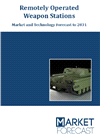After more than two decades of use in the field, Remotely Operated Weapon Stations (ROWS) have established themselves as a robust and thriving market. Their numerous advantages include enhanced crew protection, improved accuracy, higher first-round hit probability, superior target recognition and identification, as well as cost-effectiveness in production, integration, and operations. One of the most crucial benefits is the ability to significantly enhance the firepower of legacy platforms, thereby expanding their capabilities and extending their usefulness on the modern battlefield.
The outbreak of the war in Ukraine has demonstrated that a conflict between peer or near-peer adversaries is not a distant possibility but a highly likely scenario. In such confrontations, factors like firepower, long-range fires, and ISR (Intelligence, Surveillance, and Reconnaissance) play pivotal roles. However, the defence industries were ill-prepared for the demands of high-intensity warfare, struggling to meet the required capabilities. This issue has been further compounded by the risks posed by the current economic and political climate, impacting defence budgets and supply chains.
Within this challenging context, ROWS can provide significant capabilities to new and existing platforms in a timely and cost-effective manner. It is important not to overlook the significant developments in the ROWS market, as they are expected to revolutionise combat operations. Just as radio communication revolutionized technical and military affairs by guiding weapons, ROWS will bring about a similar transformation, not only as standalone systems but also when integrated into networked environments and utilized on unmanned ground or surface vehicles.

Market forecasts by Region, System Element, and End-User. Country Analysis, Market and Technology Overview, Opportunities and Impact Analysis, and Leading Company Profiles
Download free sample pages More informationThe present global security environment poses various challenges, including low-intensity conflicts. As major forces worldwide seek disruptive technologies with advanced firepower capabilities, platforms or unmanned systems equipped with ROWS, interconnected through the Internet of Military Things (IoMT) over a Command and Control (C2) backbone, will prove to be effective and economical solutions.
Recognizing the market's potential, a considerable number of manufacturers around the world are investing in developing their own ROWS. This competition fosters a dynamic and highly competitive environment for businesses, encouraging the creation of economies of scale.
Market Forecast' Remotely Operated Weapon Stations (ROWS) study provides a detailed analysis of the market up to 2031 in terms of technologies, end-users and platforms, acquisition programs, leading companies, and opportunities for manufacturers. The study also provides the case studies that would help readers better understand the nature of the market and the underlying factors affecting the procurement of ROWS.
About Market Forecast
Market Forecast is a leading provider of market intelligence studies specialising in the Defence and Aerospace market for to both private and public sector organisations.
Our comprehensive market intelligence studies offer valuable insights and identify growth opportunities for our customers within existing and emerging markets. We analyse new and current technologies, industries with their key players, market developments, and segmented present and future market sizes.
Market Forecast is a brand of the private owned company ASD Media BV and is located in Amsterdam, The Netherlands, Europe. The company exists for over fifteen years and has extensive experience with market research, computer models, and online products.
“Defence & Aerospace market intelligence by Experience & Technology”